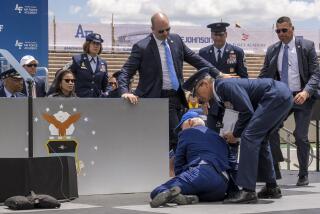Pulling back a curtain on age and weakness
FORT LAUDERDALE, FLA. — Elayne Goldhair knows about osteoporosis, the age-related disease that causes loss of bone mass. She eats plenty of fruits and vegetables, and has a bone density test every other year.
But like most people, the 86-year-old from Palm Beach, Fla., had never heard of sarcopenia, age-related loss of muscle mass.
Sarcopenia is, along with osteoporosis and dementias like Alzheimer’s disease, one of the most common reasons seniors end up in nursing homes, unable to care for themselves.
Studies suggest sarcopenia may affect 40% of people 80 or older -- about 9 million Americans -- and accounts for $18.5 billion in healthcare expenditures annually.
Yet sarcopenia remains virtually unknown among most Americans -- no public education campaigns, no commonly used screenings, no hot new sarcopenia drugs.
Several Florida health organizations are working to raise the profile of sarcopenia, a condition whose progress can be slowed through diet and exercise.
“I think the problem is that people just accept muscle loss as part of old age,” said Christy Carter, an assistant professor at the University of Florida Department of Aging and Geriatrics, who is doing research on sarcopenia in rats. “But it is a huge and growing health concern.”
Primary care doctors typically do not discuss sarcopenia with their patients. Goldhair’s physicians didn’t, although Goldhair had noticed she was starting to have a little trouble getting out of chairs, a classic sign of weakening thigh muscles.
“No one has ever mentioned sarcopenia to me,” Goldhair said.
Goldhair spent seven weeks at the Joseph L. Morse Geriatric Center in West Palm Beach after she fractured her pelvis. Her physical therapists sought to rebuild her leg muscle strength so she could go back to living on her own in her apartment.
Dr. Bernard A. Roos, a professor, researcher and director of the University of Miami Geriatrics Institute, calls sarcopenia “my little orphan.”
“There is no sarcopenia association. We don’t have pills for it and we don’t pay doctors to treat it,” said Roos, who has done numerous studies on sarcopenia.
But Roos thinks that is changing. “When I started looking at osteoporosis in 1972, people told me there never would be a cure. Now we have 20 drugs that treat it,” he said. “Before I retire, we will have sarcopenia treatments.”
Scientists still don’t understand exactly why sarcopenia occurs. Humans all begin losing some muscle as early as their 40s. Studies have focused on three areas: exercise, better nutrition and doses of testosterone or other hormones.
But there are “no clear criteria to classify someone’s muscle mass loss,” said Dr. Karl Dhana, Morse Geriatric’s medical director and a geriatrician.
As the nation’s 77 million baby boomers age -- the oldest will turn 80 in 19 years -- healthcare providers and policymakers are paying more attention to sarcopenia.
People with advanced sarcopenia can’t rise on their own from a chair, get into or out of bed, or put their groceries on a shelf. They may have trouble walking, bathing or going to the bathroom. It often is a hidden contributor to other medical conditions: heart failure, chronic obstructive pulmonary disease and some types of arthritis.
About 60% of nursing home patients have sarcopenia. Medicaid, the healthcare program for the poor that is the only government-sponsored funding for nursing home care, spent $195 million on long-term care in Florida in 2005, with 64% of it going to nursing homes.
“Sarcopenia will start to count when it impacts our wallets,” Carter said.
The University of Florida last month received a $3.9-million federal grant to establish a Claude D. Pepper Older Americans Independence Center, one of 10 centers nationwide dedicated to preventing age-related disabilities. Much of its work will involve sarcopenia research.
Yetta Steiner, 92, who lives with her daughter in Lake Worth, Fla., has neuropathy and digestive problems. But what kept her at Morse Geriatric for three weeks was the fact that she couldn’t stand or walk on her own. “Other than that, I feel fine,” said Steiner, who is doing daily exercises with leg weights.
Experts agree that activity is key to slowing sarcopenia, and studies as far back as 1990 have shown that even very elderly fitness newbies can benefit from regular exercise.
But exactly what kind of exercise reduces muscle loss, and how often it should be done, is unclear.
Michael Whitehurst, a professor of exercise science at Florida Atlantic University in Boca Raton, thinks people need to exercise four or five times a week, and include some resistance training such as weight lifting. But other recent studies have suggested even 30 minutes of walking several days a week can be helpful.
“The most important thing is to understand that getting fit and feeling fine is something we should be pursuing all of our lives,” Roos said. “If you start at 70, it will be hard.”





